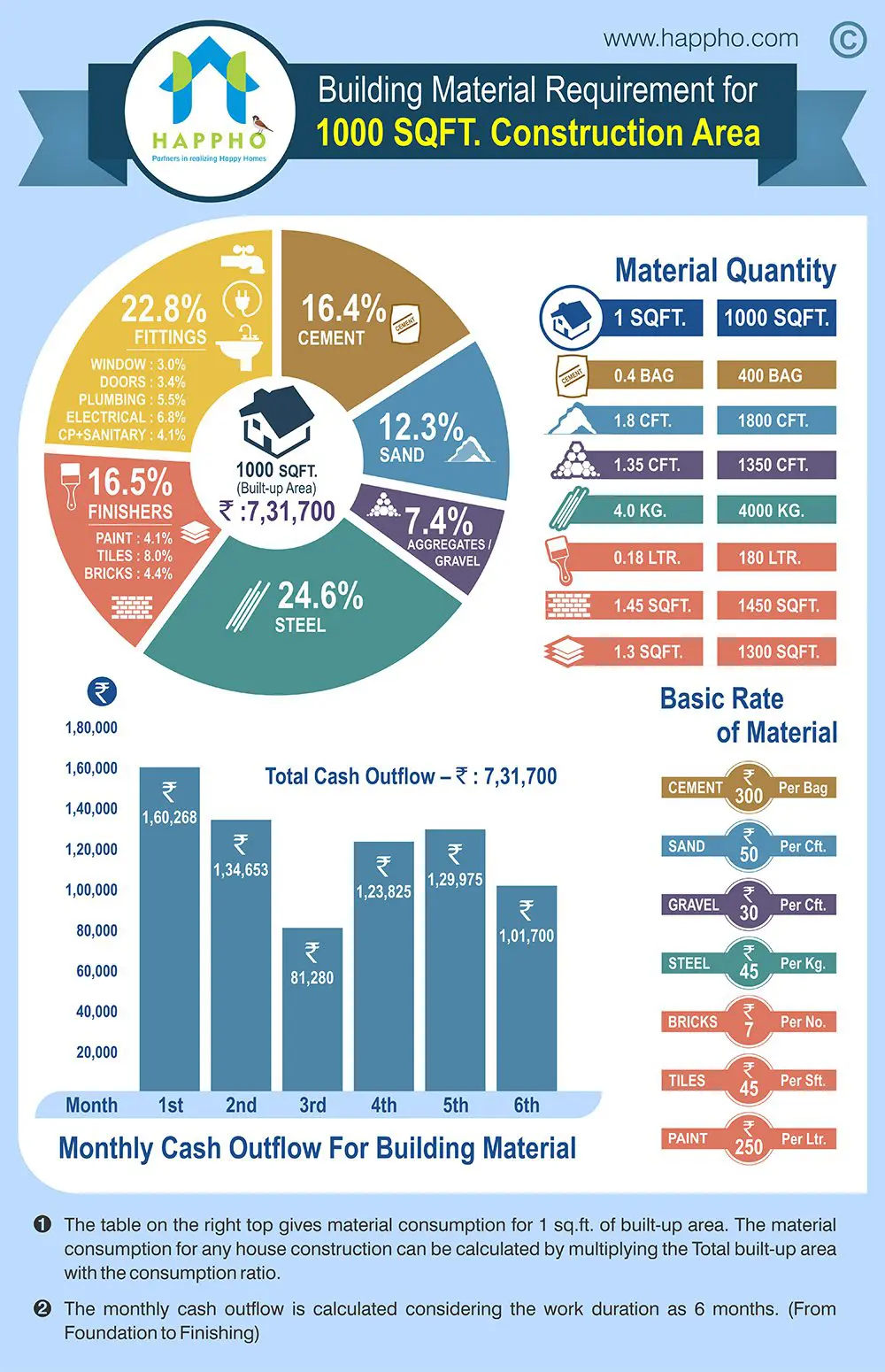Building Material
Materials that are used for Construction Purposes are called Building Materials. Building materials can be categorized into two sources, natural and synthetic. In order to construct a good quality house in the amount you have budgeted, a thorough understanding of the quality parameters, cost and quantities of these building materials are required.
| Material Required for House Construction | Quantity Required for 1 Sqft House | Quantity Required for 1000 Sqft House |
| Cement | 0.4 Bag | 400 Bag |
| Sand | 1.8 Cft | 1800 Cft |
| Aggregate | 1.35 Cft | 1350 Cft |
| Steel | 4.0 Kg | 4000 Kg |
| Paint | 0.18 Ltr | 180 Ltr |
| Bricks | 1.45 Sqft | 1450 Sqft |
| Tiles | 1.3 Sqft | 1300 Sqft |

* The infographic is prepared by averaging material consumption of more than 500 Individual House Construction Projects.
* All these materials requirements are for Framed Structure (column beam structure) and not Load bearing Structures
Factors affecting Cost of House Construction and How much Building Materials affect the cost
The cost of construction depends majorly on the following factors:
- Architectural Design opted (like Open Top, Sloped Roofs, terraces with add-on features etc.,)
- Structural Design (depends upon type of strata available for foundation and numbers of floors / configurations (basement, stilt,G+2 etc.)
- Specification of Building materials selected (Quality/Brand of materials used for painting, flooring, woodwork, Bathroom, Electrical etc.)
- Exterior Finish chosen (i.e. front elevation design, stone cladding, facade, etc.)
- Peripheral external developments (such as compound wall, driveway, landscape, hardscape, Gate etc,).
The other minor cost head would be cost of liaison, charges for construction permits & building approvals.
The Construction cost can be broadly split into Labor and Material Cost. The extremely increasing construction trends are considered the driving force behind this fast upraise of total building construction costs. Taking this trend, the material manufactures have raised the prices of materials considerably in last decade or so.
Before planning for a bungalow/individual construction unit, one must be aware of the quantities and Cost Of Building Materials as they constitute around 55-60% of the total construction cost of a house. While taking a personal round of the nearby market, one should also avail services of construction turnkey solution providers and then take a judicious decision before the start of the construction.
Refer the info graphic to get the building material consumption and their costs for a 1000 Sqft budget house construction. The material quantities can be extrapolated based on the built up area of construction you are planning for.
https://youtu.be/eDCY_LLMUc8
Building Materials required for 1000 Sqft House Construction
The major raw material, intermediately and finished construction materials contributing major pie to overall material cost are:
1. Reinforcement Steel Required for House Construction
Reinforcement Steel is the most important structural material in construction. Steel is used in RCC (Reinforcement cement concrete). Generally rebars available in the market are manufactured through Thermo mechanical treatment (TMT). Rebars comes in different grades (i.e, Fe415, Fe500, etc.,). Fe500 is generally recommended by structural designer for structural requirement fulfillment.
The approximate Steel consumption per sq.ft built up area (BUA) is 4 kg per sqft (for low rise construction i.e., less than 4 floors of construction). Steel contributes the most among all individual materials, about 25% of total material cost. So, a price rise of Rs.5 per kg can make big difference in the total cost of construction.
2. Cement Required for House Construction
Cement is an important construction material and when mixed with materials like sand, aggregates (stone chips), and water, it binds them together. It is used in concrete, in brick masonry work, in tiling, and in plaster works.
Good quality cement should feel smooth when rubbed between fingers. If a small quantity of cement is thrown into a bucket of water it should sink and not float. Cement should always be kept free from moisture. Its storage should have finished floor raised to at least 300mm above ground level and should have airtight storage. Use of cement older than 2 months should be avoided as cement loses strength with increase in its shelf life.
OPC 53 grade is generally used for concrete works and blended cement (PPC & PSC) for masonry, tiling and plaster works.
The approximate cement consumption per Sq.ft built up area (bua) is 0.4 bags per sqft. Cement as a construction material contributes about 16% of total material cost.
3. Sand required for House Construction
Sand is used mainly in Concrete, Masonry, Plaster and Flooring. Good sand should be well graded i.e., particle size ranging from 10mm to 0.150 mm for concrete and masonry works, and 5mm to 0.150 for plaster. It should be free from slit/clay and organic matter.
Natural Sand (also called River Sand) is obtained from River Beds. Due to environmental impacts and stringent laws by the government, Natural sand is slowly and gradually being replaced by Crushed sand (for concrete and masonry works) & Plaster sand (for plaster works). Crushed Sand and Plaster Sand are manufactured from Quarry Stone using latest production technology.
Sand consumption per sq.ft built up area (bua) is 1.8 cft per sqft and contributes about 12% of total material cost for building construction.
4. aggregate Required for House Construction
Crushed rocks are used as coarse Aggregates and are generally used in making concrete. Coarse aggregates are normally available in two fractions 20mm and 10mm for concrete making.
Aggregates should be clean, dense & hard. The aggregate should be neither flaky nor elongated. Flaky and Elongated aggregates decrease the strength of the concrete and demands more cement. Aggregates should be stored properly and different fractions must not be intermixed. Both these aggregate fractions should be used invariably.
Coarse aggregate (chips/gravel) consumption per sq.ft built up area (bua) is 1.35 cft per sqft. Aggregate as a construction material contributes about 8% of total material cost.
5. Bricks Required for House Construction
Bricks in old days, were commonly made of clay and were known as burnt clay bricks. Now a days, bricks are made of other materials such as fly ash. But clay bricks are still widely used in low rise residential constructions today. Bricks are used for masonry wall construction. Other substitute materials to bricks are Concrete solid/hollow blocks, Autoclaves Aerated Concrete (AAC) Blocks and Cellular light weight concrete CLC Blocks.
The clay bricks should have uniform size, uniform copper color, plain (without undulated surfaces), rectangular surfaces with parallel sides and sharp straight edges. Well burnt brick should give a metallic sound when struck with other brick. Good bricks should not exceed +/- 3 mm tolerances in length and +/- 1.5 mm tolerances in width and height. Water absorption should not exceed 20% by weight.
Bricks approximately cost Rs.7000 per 1000 units (Nos). Bricks contribute to about 5% of total material cost and are consumed approximately at 1.45 brick per sqft of built up area (BUA).
6. Tiles Required for House Construction
Ceramic tiles are generally made from red or white clay fired in a kiln. They are finished with a durable glaze which carries the color and design. Ceramic tiles are manufactured for both wall and floor, having varying degrees of wear resistance and water absorption. High strength and Low water absorption ceramic floor tiles are commonly known as Vitrified tiles. Tiles prices vary according to their types and quality.
Tile should be easy to clean, strong, sturdy and stain resistant. Tiles in wet area like bathroom should be of anti-skid floor type.
Tiles consumption per sq.ft built up area (BUA) is 1.3 sq.ft per sqft. Tiles contribute about 8.0% of total material cost.
7. Paint Required for House Construction
Paints can be broadly classified into water based or solvent based. They come in thousands of shades and gives multiples finishes like Matt, satin and glossy finish. Certain Paints also have washables, anti-algae/fungal, crack bridging properties.
When selecting an interior paint, try choosing water-based paint instead of oil-based gloss paint. Water-based paints have less odor than conventional oil-based paints.They are much easier to clean up and are durable.
When selecting an external paint look for waterproofing, anti-algae, and dirt pick resistance properties.
Paints (Internal- Emulsion and external grade) consumption per sq.ft built up area (BUA) is 0.18 liter (0.14 liter for internal painting and 0.4 for external painting).
Paints contribute about 4.1% of total material cost.
The Finishers (Bricks, Tiles, and Paints) collectively contribute 16.5% of total material cost.
8. Other Fittings required for House Construction
Window, Door, CP Fittings, Sanitary wares, Plumbing and Electrical fittings when combined contribute to 23% of total material cost considering budget brands. Top brand options may increase this category cost to 30 – 35% of the total cost of construction. Fittings can be selected based on one’s requirements and choice. In branded fittings quality should not be a concern.
Conclusion
Other than estimating the cost and quantities of construction materials, one should also have knowledge of current labor cost in local markets. This is because the labor component constitutes to 40-45% of the total cost of construction of a house.
An unskilled labor charges Rs. 450 to 500 per day whereas skilled labor such as mason, carpenter, painter, electrician etc., charges between Rs. 800 to 1000 per day. The total cost of construction (including both design, material and labor) per square feet may vary anywhere between Rs.1350 and Rs.2500 per square feet depending on the specifications of the building materials you choose for you house.
Now that you have the total cost of construction, you can start sourcing the funds required for the project. Your source might be personal savings or loan from banks/ friends. Although this sounds like a naive step, lack of resources during construction might sometime over shoot the budget.
Contractors will charge for De / Re-Mobilization. Some of the construction materials like Cement etc., might expire/loose its strength if the project is delayed by long. So sourcing the funding before the start of the project is just as important step as any other. A detailed cash flow for purchasing construction materials has been shown in the info-graphic to ensure smooth construction flow with time.






